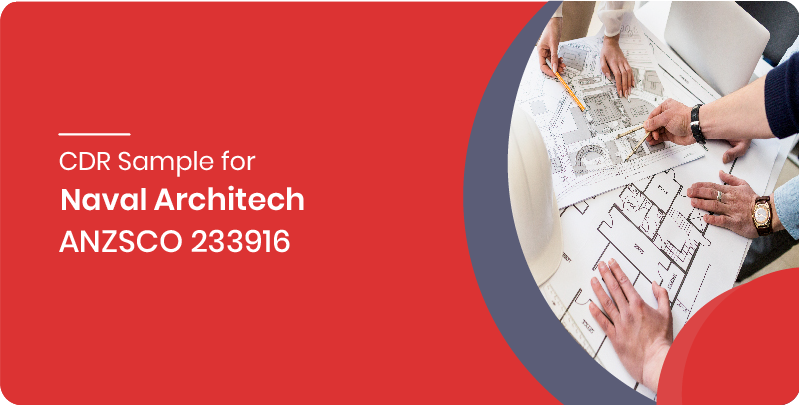CDR Sample for Naval Architect 233916
Having Trouble Writing your CDR Report ?
Get in Touch with Our Writers to get the Help you Need and Avoid Possible Rejection!
Or talk to our writers at +61 481 614 316 / +61 483 968 416
Naval Architecture: ANZSCO 233916
A naval architect fills in as a feature of a group liable for planning, delivering, and fixing safe, commendable ocean surfaces or submerged vessels. They work with a scope of vessels, including ships, ships, submarines, and yachts. Maritime engineers study plan recommendations and details to build up essential boat attributes, such as size, weight, and speed. Also, they create sectional and waterline bends of the body to build up the focal point of gravity, ideal body structure, and information on lightness and dependability. Maritime modelers by and large work for government offices, for example, the Ministry of Defense.

Competency Demonstration Report (CDR) Sample for Naval Architect
The Competency Demonstration Report Sample for Naval Architect includes all the necessary reports such as Three Career Episodes, Continuing Professional Development, Summary Statement and Curriculum Vitae. The Content of the Sample is as follow
Naval Architect Career Episode Report Samples
The career episode must be written on your own based on your recent work experience and must be in the English language. Each career episode should highlight the problems faced in your project and the steps taken to overcome them. It would be best if you numbered each paragraph of your career episodes as “ Career episode 1 (paragraphs 1.1, 1.2, 1.3, etc.) “. The primary four components are as follows:
Project Name:Green Technology Catamaran Sailboat
In first career episode, the author describes his project named “Green Technology Catamaran Sailboat”. The responsibilities of the author were:
To develop a design model with an accuracy within 10% of the expected final design
Detailed calculation and analysis of the electrical systems with a focus on energy conservation and green generation
Vessel structural analysis for the indicated sea conditions
Ship propulsion analysis to ensure vessel performance at sea trials
Weight analysis of the vessel to determine the appropriate load conditions
Project Name: Arctic Icebreaking Charter Yacht
In second Career Episode, the author demonstrates his technical skills on a capstone project designed to give experience in the preliminary design of a ship. The project was “Arctic Icebreaking Charter Yacht”. The key responsibility of the writer was:
To develop a design for an icebreaking charter yacht capable of carrying 21 passengers for an extended period of time through the eastern arctic
To produce a design while keeping the analyses’ level of detail consistent with industry standards
To create an environmentally sustainable boat that would be able to navigate the lower to mid Arctic during the winter months
To create an economically viable boat
To design a feasible vessel to meet the requirements set while providing a desirable passenger vessel.
Project Name: Computational Fluid Dynamics and Fluid Structure Interaction of Yacht Sails
In third Career Episode, the author explains the engineering skills he used in the project he was involved in. His duties and responsibilities in the project “Computational Fluid Dynamics and Fluid Structure Interaction of Yacht Sails” were:
To review the current research into modelling methods, suitable for sail flow analysis and determine their limitations
To validate the use of viscous computational fluid dynamics for the modelling of upwind and downwind sail sections
To create a fluid-structure interaction solution for the modelling of sail flow problems
To validate the fluid-structure interaction solution
To apply the fluid-structure interaction solution to the modelling of real world sail flow scenarios
Pricing of Complete CDR Writing
We provide Complete CDR writing service on the basis of your urgency level and prices respectively. There are currently three varients of service that you can purchase which are shown below.
15 days plan
$
799
AUD
10 days plan
$
999
AUD
7 days plan
$
1299
AUD
1000s of Satisfied Customers
Our Services receive great response and guarantee Success. Few client feedbacks are shown below.
Our Hundreds of Clients are getting Successful Approval, When will you?
Our primary goal is to ensure our clients' successful approval through well-documented CDR reports that match EA standards for migrants. CDR Writers Australia provides quality CDR and ACS skill assessment services, aiming for 100% skill assessment success.

Best Prices

On-time Delivery

Report Structure

100% Original Content
Feeling Curious? Get Your CDR Approved—Call Us Now! +61 481 614 316 / +61 483 968 416
We are here to answer all your queries and provide you the best service. Feel free to contact our writers for your concerns.

